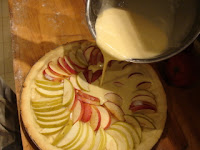The last night at the restaurant before November vacation. There is a jittery feeling about us like on the last day of school when you are eight, or twelve, or sixteen. Energy is high, and that has nothing to do with the dark chocolate we have been testing all afternoon.
We close down twice a year, in November and April, a product of the seasonality in this part of Vermont. A product of long hours, small staff, and the need to rejuvenate, give our bodies a rest. Trips have been planned, dinner invitations on weekends accepted, lists made of things we never get to do because of our schedule. The biggest problem with November vacation is there is a tendency to overbook, over do. Like children in a candy shop, we want to do this, and that, and that, and we can't forget to include that, and before we know it we have committed to too much and good-bye to rest and relaxation. Yet, we promise to be vigilant this year in an attempt to do not much of anything. At least for a day. Or two.In the kitchen, we are making bread to take home for vacation, thinking of how we will divvy up cheeses, taste testing sauces made from the autumn harvest to be put away, and the composta we've made from the black grapes and green tomatoes. We get ready for dinner service just like we always do; we have more reservations than we expected tonight, a Monday night close to November. We are full, a mixture of new and old patrons, those catching us for the first time before we go away, and those filling up in preparation for the month-long hiatus.
The diners arrive, they are watered, specialed, we take their orders, we bring them wine, we bring them dish after dish after dish. We open celebratory bottles, we light birthday candles. The diners leave, and we sit down to our own dinner. A bottle of nice wine, and a friend joins us. We toast to the season. We tell jokes. We try not to think about the stack of dishes and line of glasses awaiting in the kitchen.
Eventually, the kitchen calls, and the last of evening clean-up. Open bottles of wine and left-overs get packed up. We close up shop. It is already tomorrow.

































